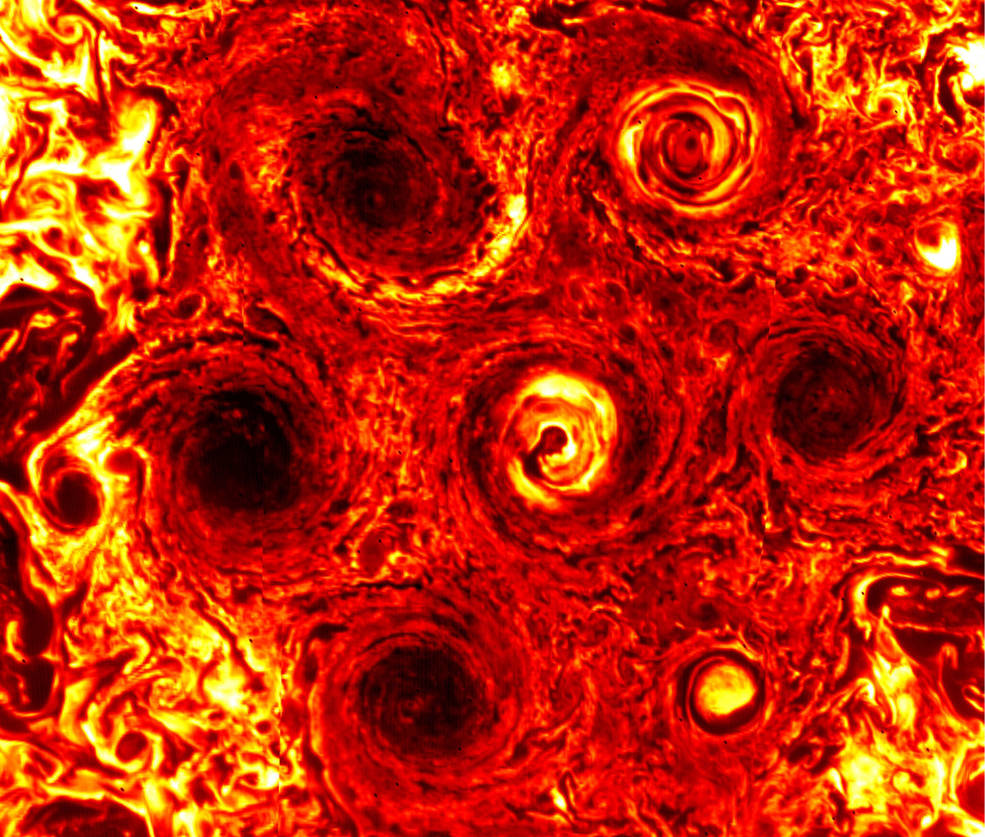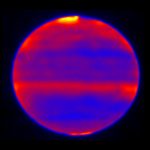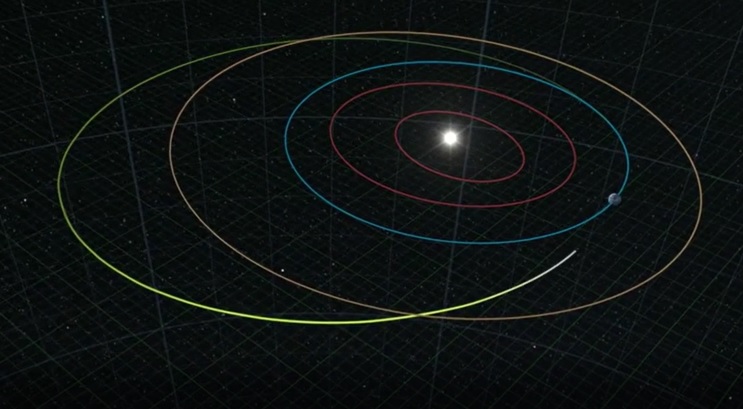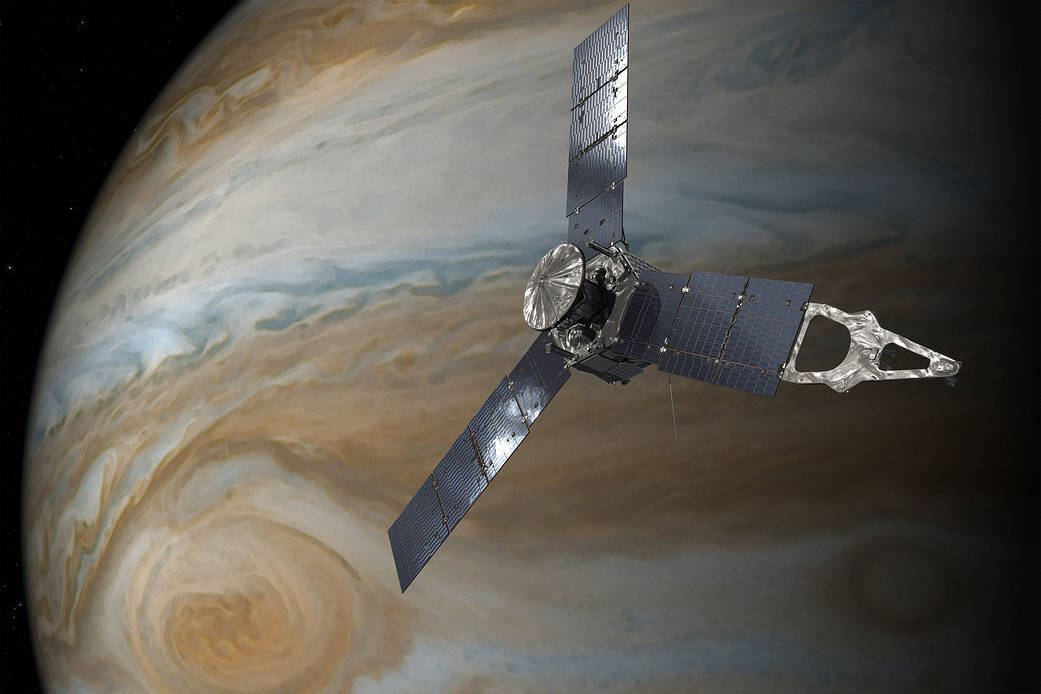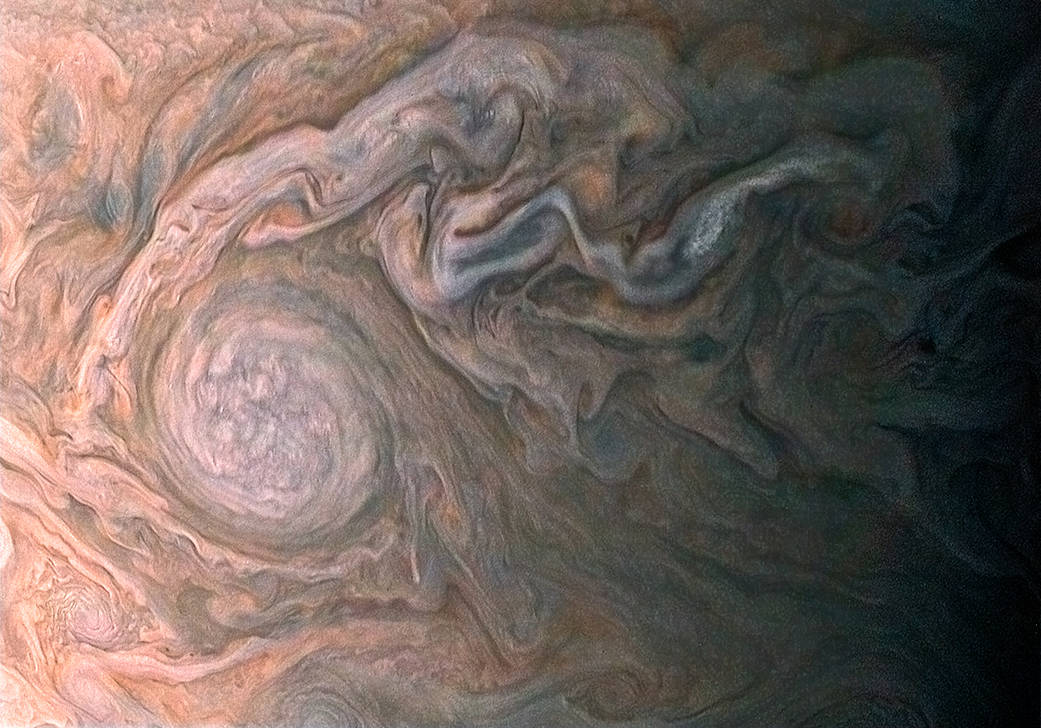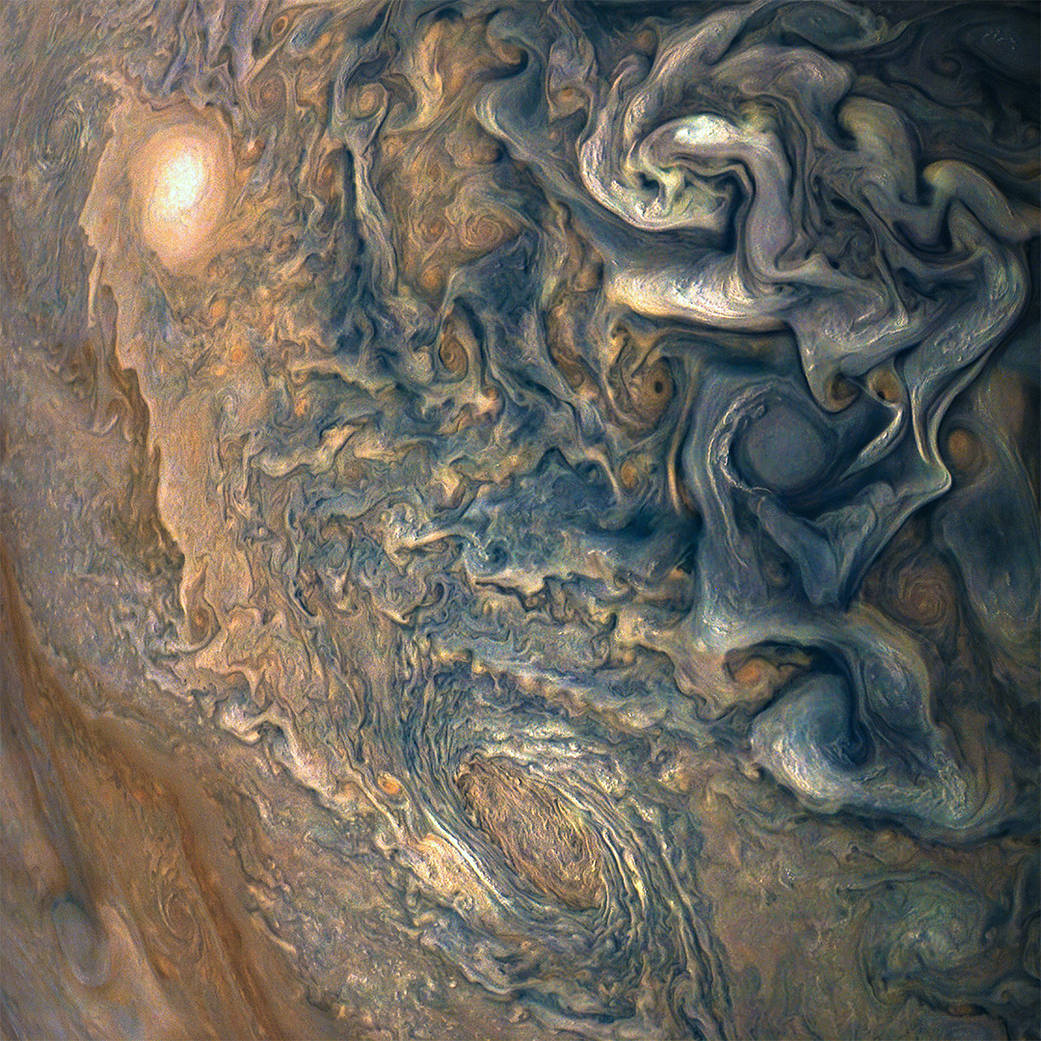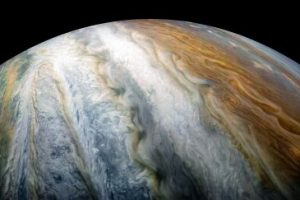NASAの公式サイトに木星の南極にあるサイクロン(嵐)に関しての情報が掲載されました。
なかなか興味深いと言いますか、少し驚かされる内容ですので、ぜひご確認下さい。
ボルトンの大げさな表現も、彼の健在ぶりを確認できてなによりでした。
記事が長いので、要約しますと以下のようなものです
- 当初木星の南極にはサイクロンがあって、中央のサイクロン周りに5つのサイクロンが五角形を形成していた(1つのサイクロンが合衆国ほどの大きさの巨大なもの)
- 木星探査機ジュノーの軌道が、木星の影に入って太陽電池の電力が途絶える危機を迎えた
- ジュノーの姿勢制御により上手く危機を脱し、観測を継続してみたところ、南極のサイクロンが新たに1つ増えていた
- そして中央のサイクロンの周りに6つのサイクロンが六角形を形成していた
注:記事中の画像は、クリックすると別ページで拡大表示します
NASA’s Juno Navigators Enable Jupiter Cyclone Discovery
トップ画像の説明
A new, smaller cyclone can be seen at the lower right of this infrared image of Jupiter’s south pole taken on Nov. 4, 2019, during the 23rd science pass of the planet by NASA’s Juno spacecraft.Credits: NASA/JPL-Caltech/SwRI/ASI/INAF/JIRAM
NASAの木星探査機ジュノーによる23回目の木星探査が実施され、その際の2019年11月4日に撮影された木星の南極の赤外線画像に、右下に新しい小さなサイクロンを見ることができます。 Credits: NASA/JPL-Caltech/SwRI/ASI/INAF/JIRAM
記事本文
出典:NASAの公式サイト(https://www.nasa.gov/feature/jpl/nasas-juno-navigators-enable-jupiter-cyclone-discovery)
Jupiter’s south pole has a new cyclone. The discovery of the massive Jovian tempest occurred on Nov. 3, 2019, during the most recent data-gathering flyby of Jupiter by NASA’s Juno spacecraft. It was the 22nd flyby during which the solar-powered spacecraft collected science data on the gas giant, soaring only 2,175 miles (3,500 kilometers) above its cloud tops. The flyby also marked a victory for the mission team, whose innovative measures kept the solar-powered spacecraft clear of what could have been a mission-ending eclipse.
木星の南極に新しいサイクロンを発見しました。 今回発見された木星の巨大なサイクロンは、NASAの木星探査機ジュノーによる木星の最新探査中の2019年11月3日に発生したものです。 太陽光発電による動力の探査機が木星のデータ収集をしたのは、22回目の木星接近時であり、木星の大気上空2,175マイル(3,500キロメートル)まで接近してのものでした。 その時の探査活動は、ミッション終了日に日食になる可能性があったのですが、革新的な対処法でミッションチームの勝利で探査活動を全うすることができました。
“The combination of creativity and analytical thinking has once again paid off big time for NASA,” said Scott Bolton, Juno principal investigator from the Southwest Research Institute in San Antonio. “We realized that the orbit was going to carry Juno into Jupiter’s shadow, which could have grave consequences because we’re solar powered. No sunlight means no power, so there was real risk we might freeze to death. While the team was trying to figure out how to conserve energy and keep our core heated, the engineers came up with a completely new way out of the problem: Jump Jupiter’s shadow. It was nothing less than a navigation stroke of genius. Lo and behold, first thing out of the gate on the other side, we make another fundamental discovery.”
「創造力と分析的思考を組み合わせることが、NASAにとって再び偉大な瞬間をもたらしたのです。」と、サンアントニオのサウスウェスト研究所のジュノー主任研究者であるスコット・ボルトンは述べています。 「ジュノーは太陽光を使用しているので、ジュノーの軌道が木星の影の部分を通過する際に重大な結果を招く可能性があることは分かっていました。それはエネルギー源を失い完全に死んでしまうリスクに直面していたということです。そして技術者たちはこの木星の影に入る問題を解決する、エネルギーを節約し動力コアを熱くする全く新しい方法を思いつきました。それは天才的な着想が閃いたことに他なりませんでした。我々は追い込まれると、全く違う発想で根本的な解決を見出すことができると示すことができて、いや正直なところ驚いています。」
When Juno first arrived at Jupiter in July 2016, its infrared and visible-light cameras discovered giant cyclones encircling the planet’s poles — nine in the north and six in the south. Were they, like their Earthly siblings, a transient phenomenon, taking only weeks to develop and then ebb? Or could these cyclones, each nearly as wide as the continental U.S., be more permanent fixtures?
2016年7月にジュノーが初めて木星に到達した時、赤外線および可視光カメラで木星の極を取り巻く巨大なサイクロンを映し出しました。サイクロンは北極に9つ、南極に6つありました。 木星のサイクロンは、地球上のものと同じように過渡的な現象で、たった数週間で発生してから衰退してしまうのでしょうか? あるいは米国本土とほぼ同じ幅もある巨大なサイクロンは、それぞれずっと存在し続けるものなのでしょうか?
With each flyby, the data reinforced the idea that five windstorms were swirling in a pentagonal pattern around a central storm at the south pole and that the system seemed stable. None of the six storms showed signs of yielding to allow other cyclones to join in.
木星に最接近する度に、南極の5つのサイクロンが中央のサイクロンの周りに五角形のパターンで渦巻いており、安定して存在しているように見えるというように考えていました。 6つのサイクロンのいずれも、他のサイクロンが入り込む余地を与えるような素振りを見せることがなかったからです。
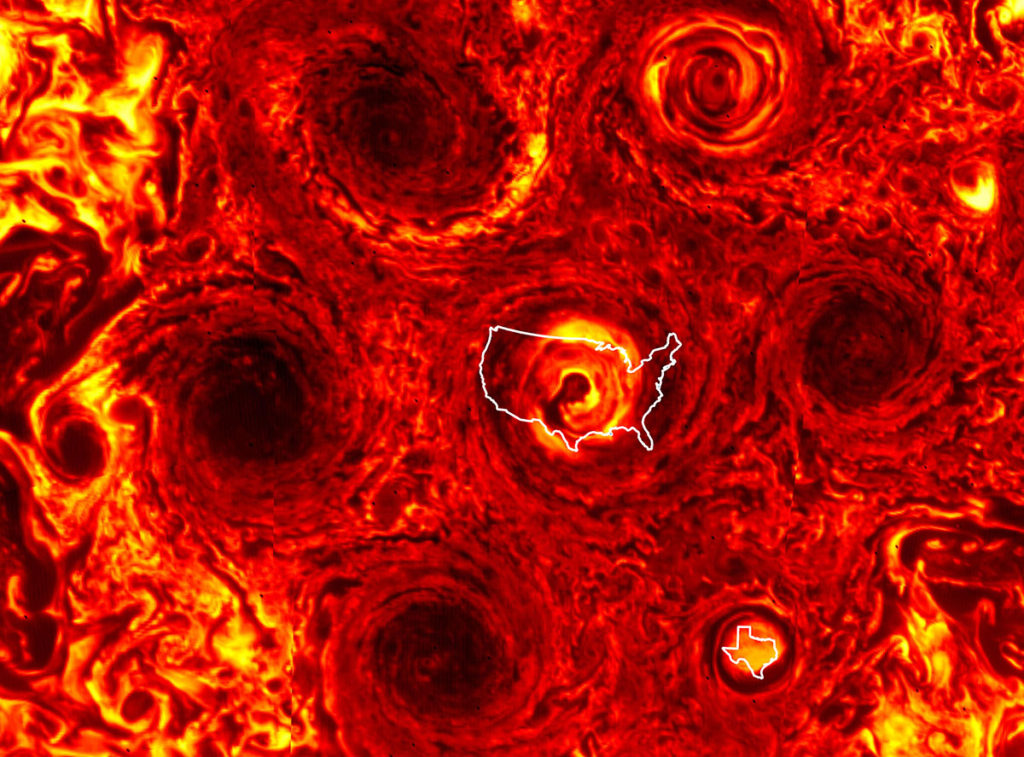
サイクロンの巨大さの感覚を掴みやすいように、木星の南極にある中央サイクロンの上にアメリカ本土の輪郭と、新らしいサイクロンの上にテキサスの輪郭を重ねてあります。サイクロンの六角形の配置は、地球を小型化したかのような大きさを持っています。
Credits: :NASA / JPL-Caltech / SwRI / ASI / INAF / JIRAM
“It almost appeared like the polar cyclones were part of a private club that seemed to resist new members,” said Bolton.
「この極に存在しているサイクロンは、新規加入の会員を拒むプライベートクラブのように見えるね。」とボルトンは述べました。
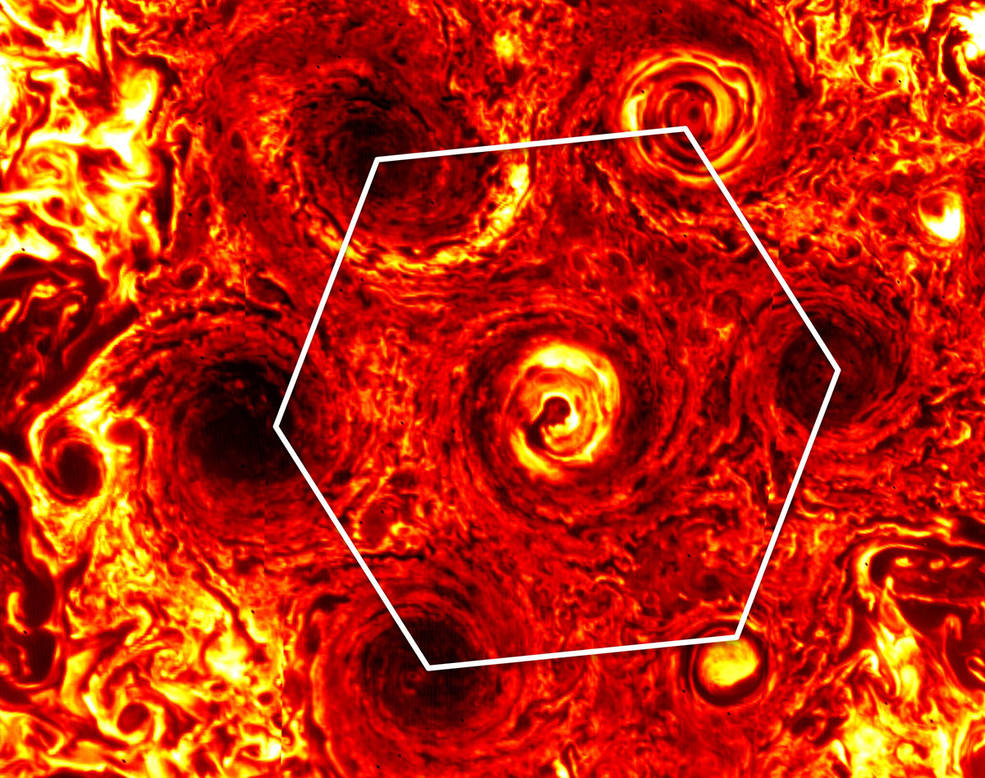
Credits: NASA/JPL-Caltech/SwRI/ASI/INAF/JIRAM
この六角形の輪郭を重ねた赤外線画像で、6つのサイクロンが木星の南極の中央サイクロンの周りに六角形のパターンを形成しているのがよくわかります。 画像は、2019年11月4日にNJASAの木星探査機ジュノーによって得られたデータから生成しました。
Credits :NASA / JPL-Caltech / SwRI / ASI / INAF / JIRAM
Then, during Juno’s 22nd science pass, a new, smaller cyclone churned to life and joined the fray.
ジュノーの22回目の探査活動の際に、新しい小さなサイクロンが誕生しサイクロンの間に割って入りました。
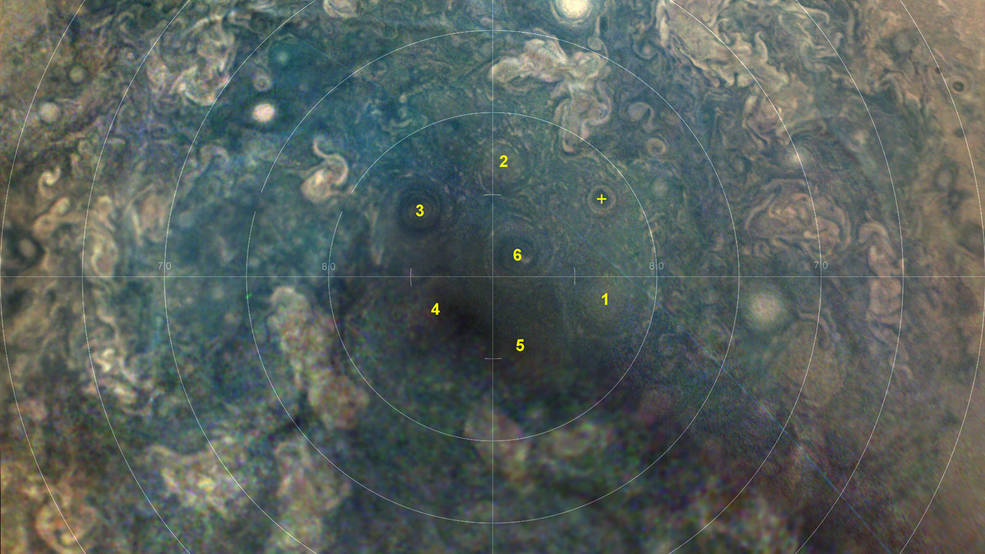
Credits: NASA/JPL-Caltech/SwRI/MSSS/JunoCam
2019年11月3日にNASAの探査機ジュノーに搭載されているジュノーカムによって撮影された合成可視光画像は、木星の南極にある新しいサイクロンが5つのサイクロンに加わり、一つの大きなサイクロンの周りに六角形を作成したことを示しています。
Credits :NASA / JPL-Caltech / SwRI / MSSS / JunoCam
The Life of a Young Cyclone
“Data from Juno’s Jovian Infrared Auroral Mapper [JIRAM] instrument indicates we went from a pentagon of cyclones surrounding one at the center to a hexagonal arrangement,” said Alessandro Mura, a Juno co-investigator at the National Institute for Astrophysics in Rome. “This new addition is smaller in stature than its six more established cyclonic brothers: It’s about the size of Texas. Maybe JIRAM data from future flybys will show the cyclone growing to the same size as its neighbors.”
「ジュノー搭載の木星の極撮影用赤外線カメラ [JIRAM]からのデータは、中央のサイクロンを囲む形状が五角形から六角形の配置に変わったことを示しています。」と、ローマ国立天体物理研究所のジュノー共同研究者であるアレッサンドロ・ムラは述べています。 「この新らしく加わったサイクロンは、ほかの既存のサイクロンより小さい。テキサス州くらいのサイズだ。おそらく、将来の木星接近の観測でJIRAMのデータはサイクロンが他と同じ大きさまで成長することを示すことになるだろう。」
Probing the weather layer down to 30 to 45 miles (50 to 70 kilometers) below Jupiter’s cloud tops, JIRAM captures infrared light emerging from deep inside Jupiter. Its data indicate wind speeds of the new cyclone average 225 mph (362 kph) — comparable to the velocity found in its six more established polar colleagues.
JIRAMは、木星の大気最上層の30〜45マイル(50〜70キロメートル)の高度まで気象状態を観測し、木星の奥深くから発せられる赤外線を捉えることができます。 そのデータから、新しいサイクロンの風速が平均で225 mph(362 kph)であることがわかりました。これは既に存在していた他の6つのサイクロンの風速に匹敵します。
The spacecraft’s JunoCam also obtained visible-light imagery of the new cyclone. The two datasets shed light on atmospheric processes of not just Jupiter but also fellow gas giants Saturn, Uranus and Neptune as well as those of giant exoplanets now being discovered; they even shed light on atmospheric processes of Earth’s cyclones.
探査機のジュノーカムは、新しいサイクロンの可視光画像も撮影しました。 この2種類のデータは、木星だけでなく、同様な巨大ガス惑星である土星、天王星、海王星、および現在発見されている巨大外惑星の大気プロセスにも光を当てています。この知見は地球のサイクロンの大気プロセスにも光を当てることになりました
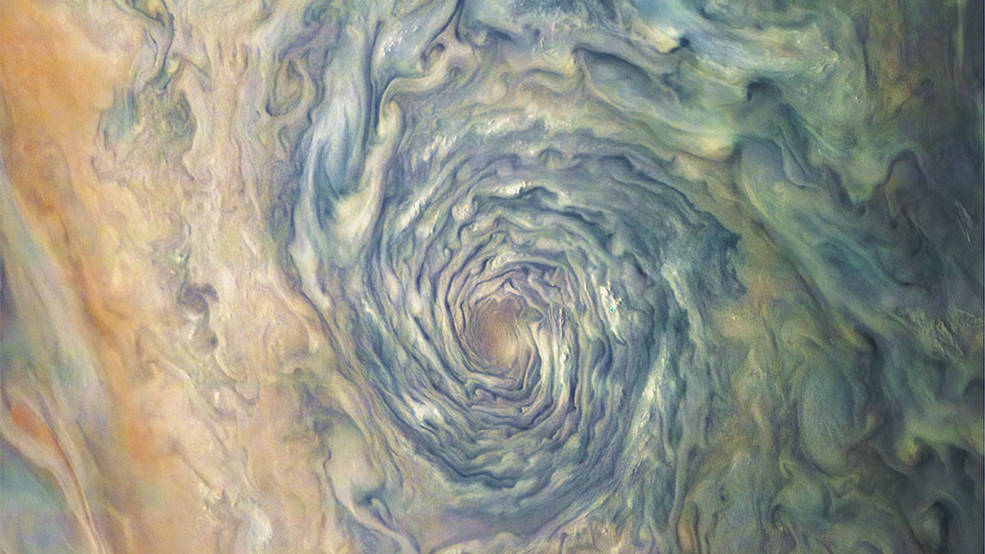
Credits: Image data: NASA/JPL-Caltech/SwRI/MSSS Image processing by Gerald Eichstädt/Seán Doran, © BY NC ND
柔らかいパステル色で、木星の雲の渦とサイクロンの豊かな色あいが強調されています。ジュノー搭載のジュノーカムによって撮影された木星の渦の画像は、巨大なサイクロンの驚くべき内部構造を捉えています。
Credits: Image data: NASA/JPL-Caltech/SwRI/MSSS Image processing by Gerald Eichstädt/Seán Doran, © BY NC ND
“These cyclones are new weather phenomena that have not been seen or predicted before,” said Cheng Li, a Juno scientist from the University of California, Berkeley. “Nature is revealing new physics regarding fluid motions and how giant planet atmospheres work. We are beginning to grasp it through observations and computer simulations. Future Juno flybys will help us further refine our understanding by revealing how the cyclones evolve over time.”
「これらのサイクロンは、これまで見たことも予測したこともない新しい気象現象です。」と、カリフォルニア大学バークレー校のジュノー科学者チェン・リーは述べています。 「自然は、流体の動きと巨大な惑星大気の動きに関する新しい物理理論を明らかにしています。我々は観測結果とコンピューターシミュレーションを通じて理解を始めています。今後のジュノーの木星観測によって、サイクロンが時間とともにどのように変化するかわかる明らかになることで、理解がまることでしょう。」
Shadow Jumping
Of course, the new cyclone would never have been discovered if Juno had frozen to death during the eclipse when Jupiter got between the spacecraft and the Sun’s heat and light rays.
もちろん、ジュノーが木星と太陽の間に入った際にジュノーが太陽光を受けられずに停止してしまっていたら、新しいサイクロンは決して発見されなかったでしょう。
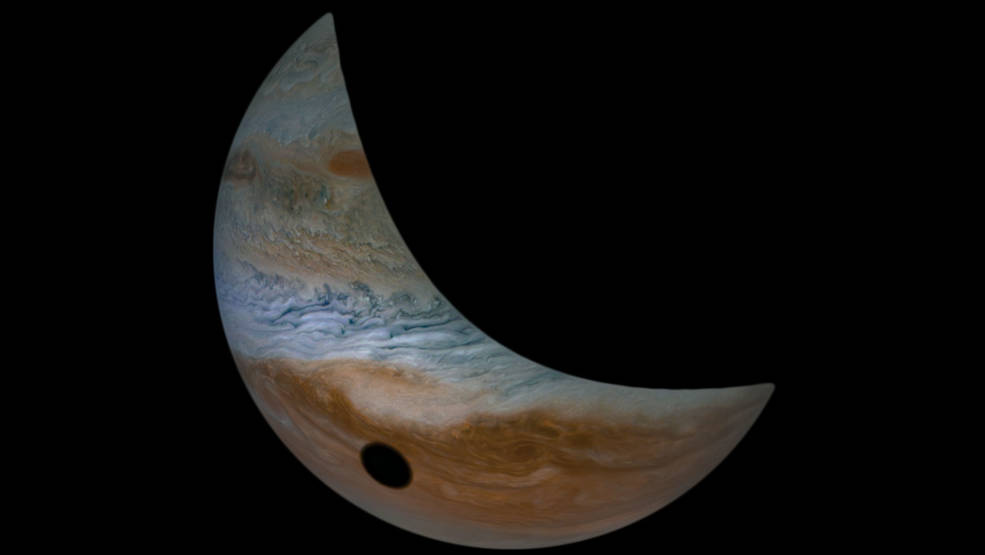
Credits: Image data: NASA/JPL-Caltech/SwRI/MSSS Image processing by Tanya Oleksuik, © CC BY
木星の衛星であるイオは、木星から見ると太陽の前を通過するたびに木星に影を落とします。
Credits: Image data: NASA/JPL-Caltech/SwRI/MSSS Image processing by Tanya Oleksuik, © CC BY
Juno has been navigating in deep space since 2011. It entered an initial 53-day orbit around Jupiter on July 4, 2016. Originally, the mission planned to reduce the size of its orbit a few months later to shorten the period between science flybys of the gas giant to every 14 days. But the project team recommended to NASA to forgo the main engine burn due to concerns about the spacecraft’s fuel delivery system. Juno’s 53-day orbit provides all the science as originally planned; it just takes longer to do so. Juno’s longer life at Jupiter is what led to the need to avoid Jupiter’s shadow.
ジュノーは2011年から深宇宙での航行を続けています。最初に木星の53日間の軌道に入ったのは 2016年7月4日でした。当初の計画では数か月後に軌道のサイズを縮小し、 14日毎に木星に接近するというものでした。 しかしプロジェクトチームは、探査機の燃料供給システムに関する懸念から、メインエンジンの燃焼を控えるようにNASAに提案しました。 ジュノーの53日間の軌道では、当初計画された全てのデータを提供するには時間がかかります。 木星でジュノーがより長い期間活動するために、木星の影を避ける必要性につながったのです。
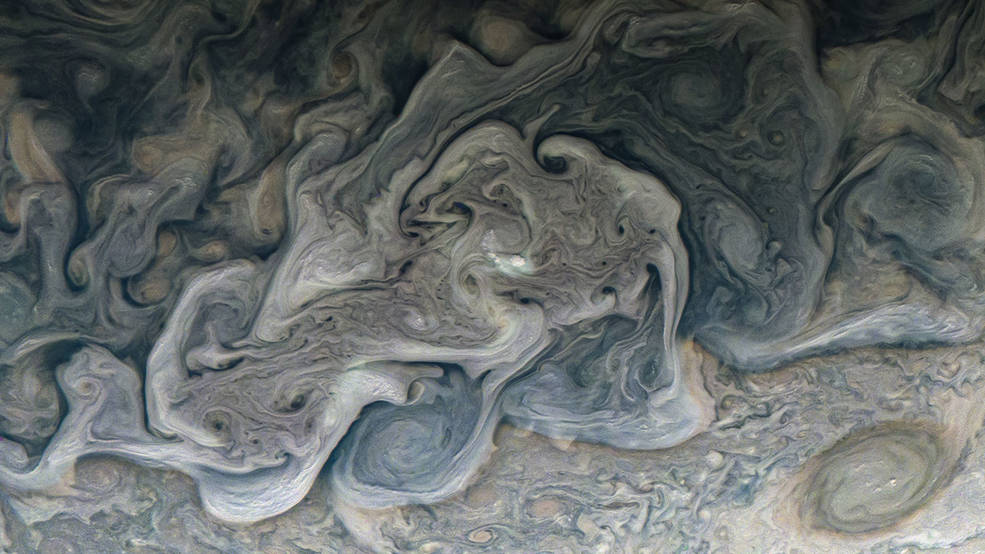
“Ever since the day we entered orbit around Jupiter, we made sure it remained bathed in sunlight 24/7,” said Steve Levin, Juno project scientist at NASA’s Jet Propulsion Laboratory in Pasadena, California. “Our navigators and engineers told us a day of reckoning was coming, when we would go into Jupiter’s shadow for about 12 hours. We knew that for such an extended period without power, our spacecraft would suffer a similar fate as the Opportunity rover, when the skies of Mars filled with dust and blocked the Sun’s rays from reaching its solar panels.”
「木星周回軌道に入った日以来、木星が24時間365日日光浴びていることを確認しました」と、カリフォルニア州パサデナにあるNASAのジェット推進研究所のジュノープロジェクト科学者であるスティーブ・レビンは述べています。「軌道計算技術者とエンジニアは、計算上ジュノーが約12時間木星の影に入ってしまう日が来ると報告してきました。私たちはそのような長い時間エネルギーを失えば、火星でのローバーのような運命になってしまうことを知っていました。ローバーは火星の空を満たすほこりで、太陽の光が太陽電池パネルに到達するのが妨げられたのでした。」
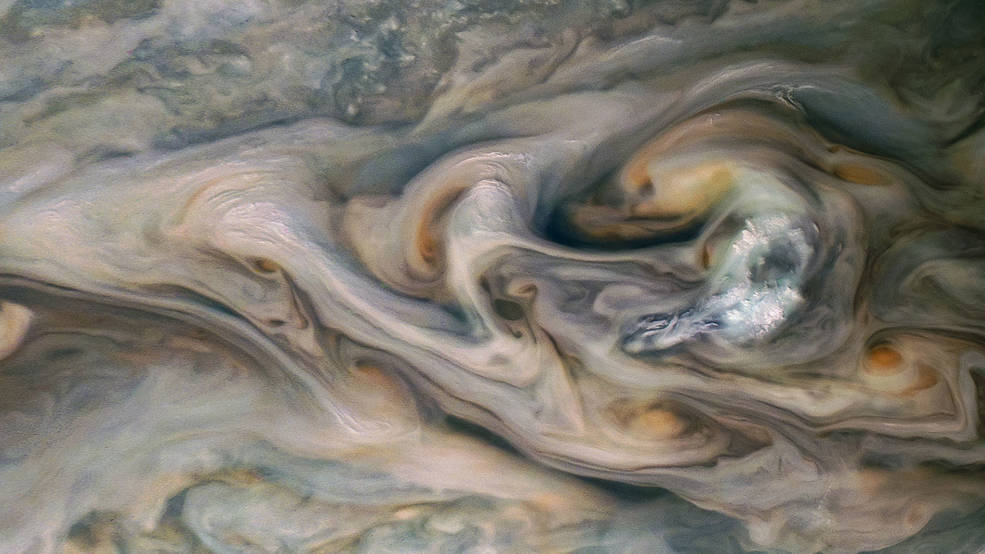
Credits: Image data: NASA/JPL-Caltech/SwRI/MSSS Image processing by Kevin M. Gill, © CC BY
ジュノーの20回目の接近時にジュノーカムで撮影された画像から、木星の雲が光り輝く美しを持っていることがわかります。 Credits: Image data: NASA/JPL-Caltech/SwRI/MSSS Image processing by Kevin M. Gill, © CC BY
Without the Sun’s rays providing power, Juno would be chilled below tested levels, eventually draining its battery cells beyond recovery. So the navigation team set devised a plan to “jump the shadow,” maneuvering the spacecraft just enough so its trajectory would miss the eclipse.
太陽の光が電力を供給しないと、ジュノーは機能確認されている温度以下に冷却され、最終的にはバッテリーセルが回復しきれなくなります。 そのため、軌道計算チームは「影を飛び越える」計画を考案し、その軌道が日食から逃げるように探査機を操縦しました。
“In deep space, you are either in sunlight or your out of sunlight; there really is no in-between,” said Levin.
「深宇宙では、日光が当たるか、日光が当たらないかのどちらかです。その中間はありません」とレビンは言いました。
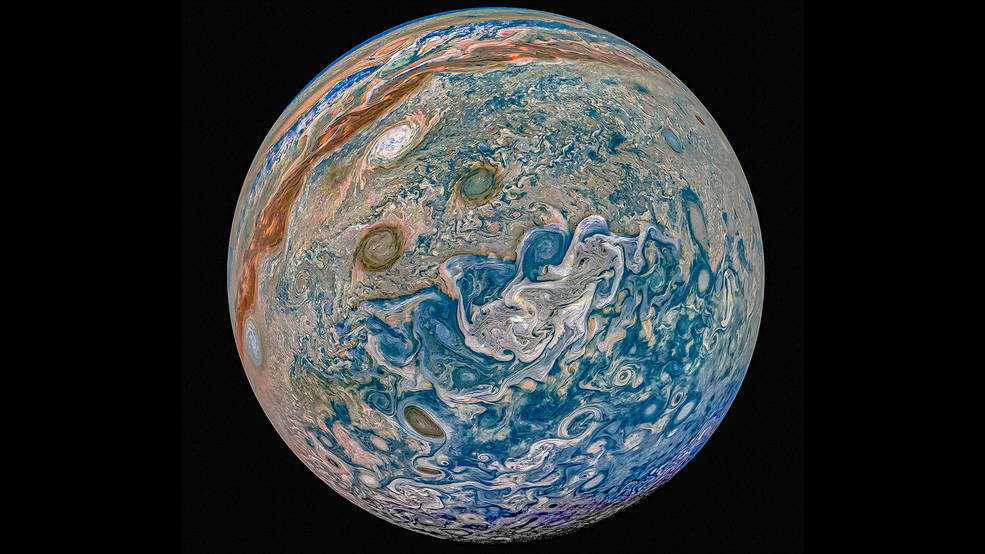
Credits: Image data: NASA/JPL-Caltech/SwRI/MSSS Image processing by Prateek Sarpal, © CC NC SA
「限界の精神、思考のカメラ」は、市民科学者プラテク・サルパルの貢献の呼称です。 木星は、その美しさで芸術家や科学者を魅了します。 この画像では、南が上にあり、強調された色調は、エキゾチックな大理石と子供の頃感じていたようなわくわく感を呼び起こします。
Credits: Image data: NASA/JPL-Caltech/SwRI/MSSS Image processing by Prateek Sarpal, © CC NC SA
The navigators calculated that if Juno performed a rocket burn weeks in advance of Nov. 3, while the spacecraft was as far in its orbit from Jupiter as it gets, they could modify its trajectory enough to give the eclipse the slip. The maneuver would utilize the spacecraft’s reaction control system, which wasn’t initially intended to be used for a maneuver of this size and duration.
軌道計算担当者は、11月3日の数週間前にジュノーがロケット燃焼を行った場合、探査機が木星軌道上にある限り、軌道を修正して日食から抜け出ることができると計算しました。 起動操作は、探査機の姿勢制御システムを利用します。このシステムは当初、この規模と期間の操作に使用することは意図していませんでした。
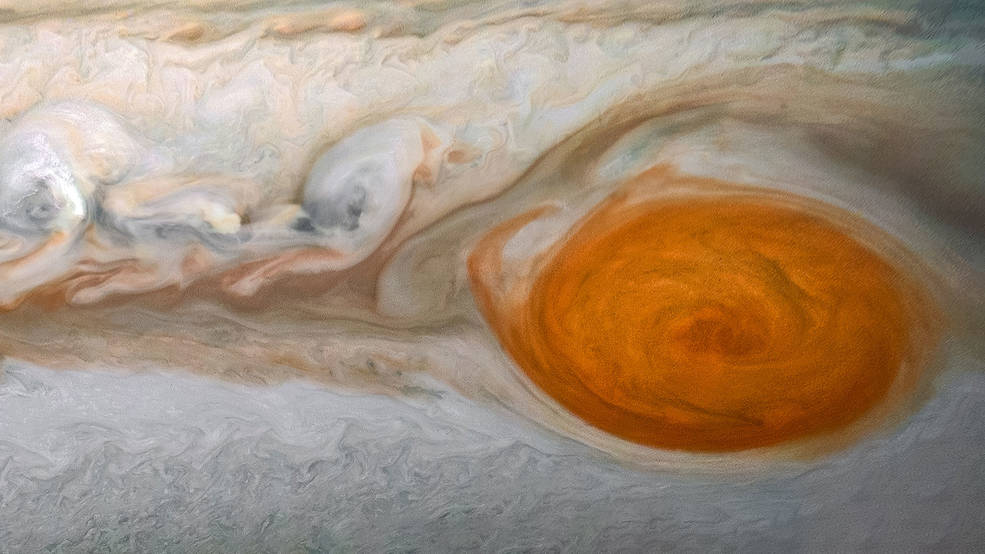
Credits: Image data: NASA/JPL-Caltech/SwRI/MSSS Image processing by Kevin M. Gill, © CC BY
何百年もの間、木星の大気中で渦巻いていた大赤斑は、ジュノー搭載のジュノーカムでクローズアップ撮影されました。
Credits: Image data: NASA/JPL-Caltech/SwRI/MSSS Image processing by Kevin M. Gill, © CC BY
On Sept. 30, at 7:46 p.m. EDT (4:46 p.m. PDT), the reaction control system burn began. It ended 10 ½ hours later. The propulsive maneuver — five times longer than any previous use of that system — changed Juno’s orbital velocity by 126 mph (203 kph) and consumed about 160 pounds (73 kilograms) of fuel. Thirty-four days later, the spacecraft’s solar arrays continued to convert sunlight into electrons unabated as Juno prepared to scream once again over Jupiter’s cloud tops.
9月30日午後7時46分 EDT(午後4時46分 PDT)、姿勢制御システムの燃焼が始まりました。 10時間半後に終了しました。 軌道制御の操縦(そのシステムの以前の使用からすると5倍も長い間)により、ジュノーの軌道速度を126 mph(203 kph)に変化させ、約160ポンド(73 kg)の燃料を消費しました。 34日後、ジュノーが再び木星大気の上空で危険な状態にありましたが、探査機の太陽電池アレイは太陽の光を電気に変換し続けました。
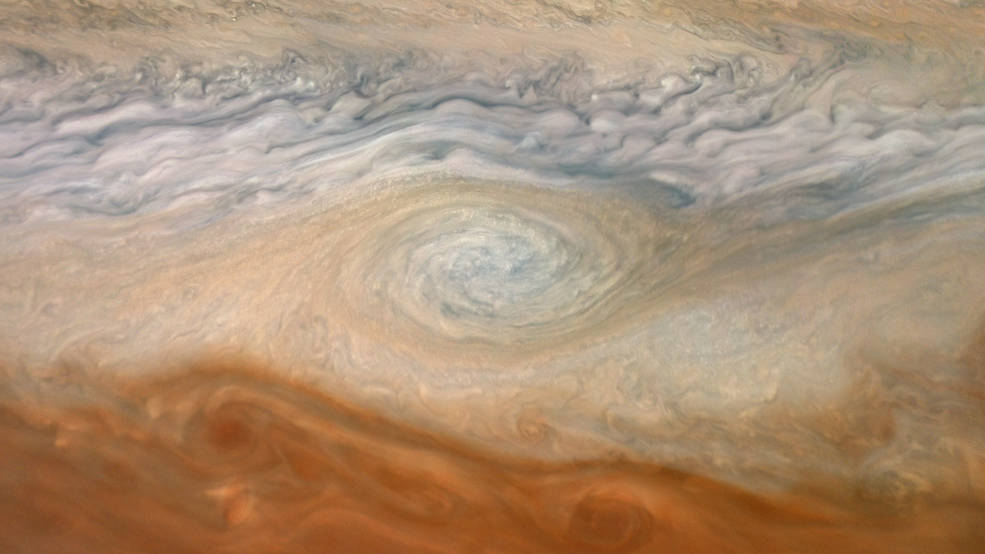
Credits: NASA/JPL-Caltech/SwRI/MSSS Image processing by Björn Jónsson, © CC NC SA
NASAのジュノー探査機は、木星大気にある長命の嵐の1つである白斑Zの画像を撮影しました。 「白斑Z」は、木星の大気中にある長命の嵐の1つです。 ジュノーの21回目の木星通過の際にジュノーカムで撮影した3つの画像を使って合成し、赤褐色の北赤道帯の真上に位置するこの楕円形の嵐の様子を示しています。
Credits: NASA/JPL-Caltech/SwRI/MSSS Image processing by Björn Jónsson, © CC NC SA
“Thanks to our navigators and engineers, we still have a mission,” said Bolton. “What they did is more than just make our cyclone discovery possible; they made possible the new insights and revelations about Jupiter that lie ahead of us.”
「軌道計算技術者とエンジニアのおかげで、私たちにはまだミッションを続けることができます。」とボルトンは言いました。 「彼らがしたことは、サイクロンの発見を可能にしただけではありません。彼らは、私たちの前に横たわっている木星についての新らたな分析と知見を得ることを可能にしてくれたのです。」
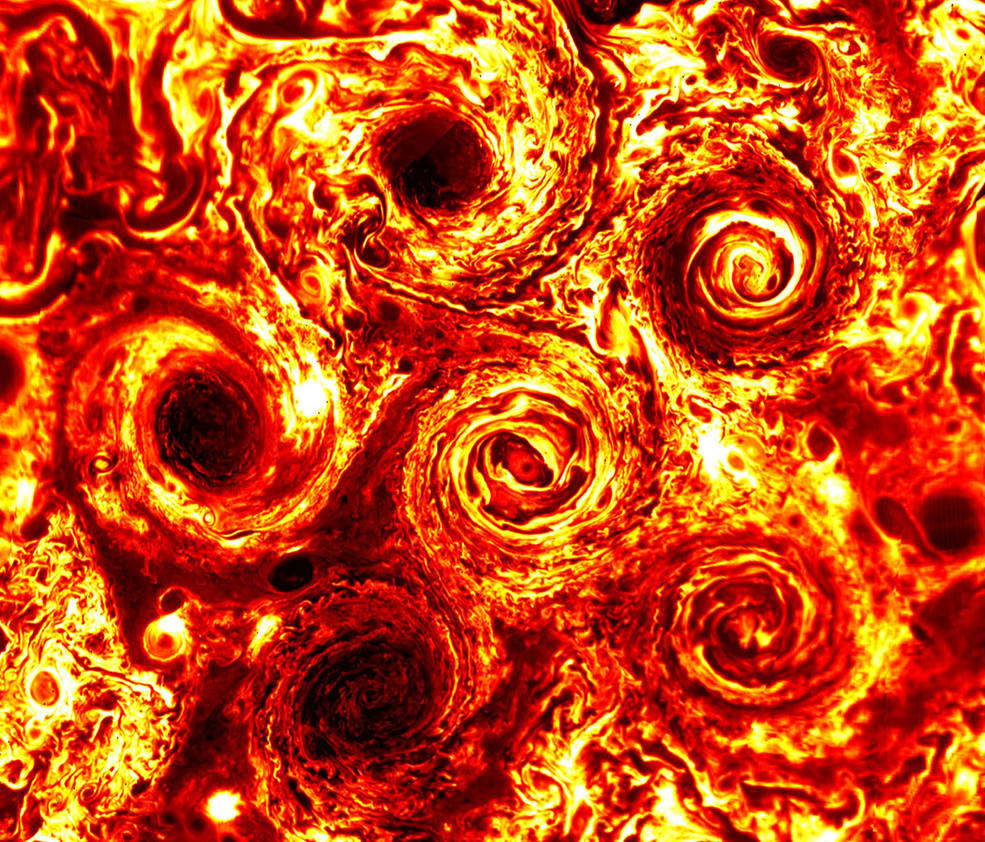
Credits: NASA/JPL-Caltech/SwRI/ASI/INAF/JIRAM
NASAのジュノー探査機の3回目の探査活動中である2017年2月2日に撮影されたこの赤外線画像では、木星の南極で6つのサイクロンが見られます。ジュノーに搭載されている極赤外線カメラ(JIRAM)は、約5ミクロンの赤外線波長で木星から放射される熱を測定します。
Credits: NASA/JPL-Caltech/SwRI/ASI/INAF/JIRAM
investigator, Scott Bolton, of the Southwest Research Institute in San Antonio. Juno is part of NASA’s New Frontiers Program, which is managed at NASA’s Marshall Space Flight Center in Huntsville, Alabama, for NASA’s Science Mission Directorate in Washington. The Italian Space Agency (ASI) contributed the Jovian Infrared Auroral Mapper. Lockheed Martin Space in Denver built and operates the spacecraft.
スコット・ボルトン はサンアントニオのサウスウェスト研究所の調査員です。 ジュノーは、ワシントン州のNASAの科学ミッション総局のアラバマ州ハンツビルにあるNASAのマーシャル宇宙飛行センターで管理されているNASAのニューフロンティアプログラムの一部です。 イタリア宇宙機関(ASI)はJovian Infrared Auroral Mapperに貢献しました。 デンバーのロッキード・マーティン・スペースが探査機を製造・運営しています。
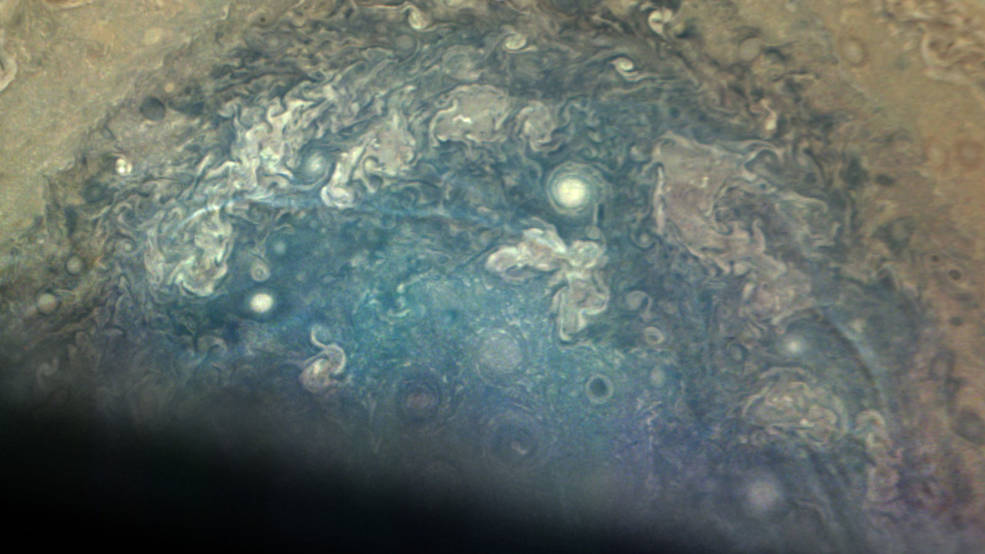
Credits: NASA/JPL-CaltechNASA/JPL-Caltech/SwRI/MSSS
2019年11月3日に23回目のジュノーの接近観測軌道からの一連のジュノーカムで撮影画像は、木星の南極周辺で6番目のサイクロンを映し出していました
Credits: NASA/JPL-CaltechNASA/JPL-Caltech/SwRI/MSSS
More information about Juno is available at:
https://www.missionjuno.swri.edu
More information on Jupiter is at:
The public can follow the mission on Facebook and Twitter at:
DC Agle
Jet Propulsion Laboratory, Pasadena, Calif.
818-393-9011
agle@jpl.nasa.gov
Alana Johnson
NASA Headquarters, Washington
202-672-4780
alana.r.johnson@nasa.gov
Deb Schmid
Southwest Research Institute, San Antonio
210-522-2254
dschmid@swri.org
2019-248Last Updated: Dec. 13, 2019Editor: Tony Greicius
